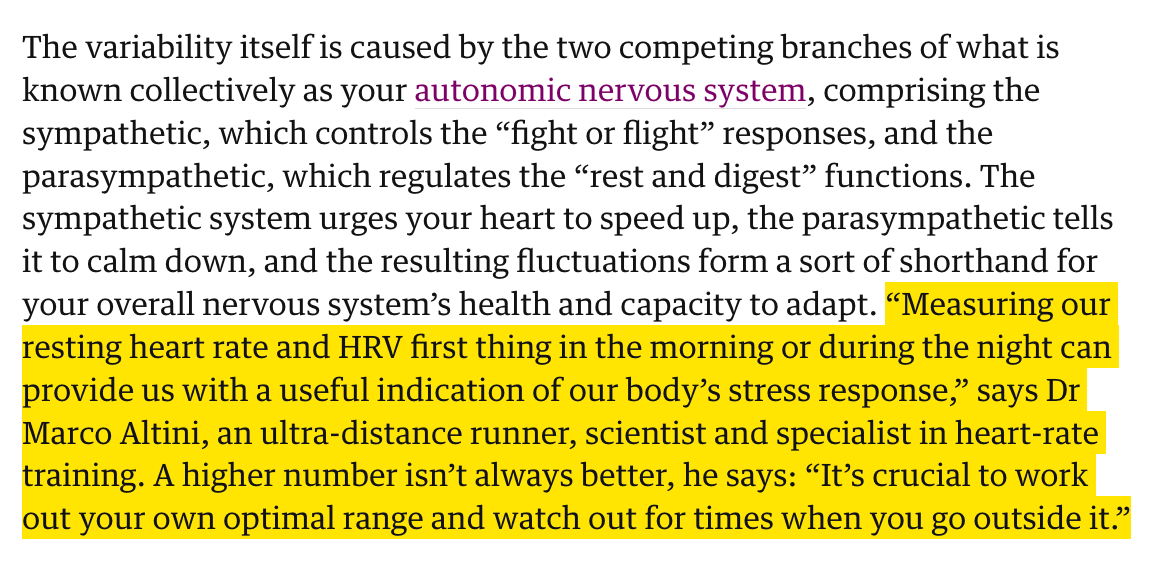January 2024 Newsletter 💫
heart rate variability, wearables, entrepreneurship, training talk and some ramblings
hi there 👋
I hope all is well and you had a good start of the new year.
Here is my first newsletter for 2024. I hope you’ll find it useful and would like to thank you for your support.
Please feel free to comment below or in the articles should you have any questions, and I will follow up.
Take care!
Heart rate variability (HRV) and wearables 🫀⌚️
Example: morning vs night HRV measurement. In this short blog, I look at important differences between morning and night HRV data, as these two protocols and the resulting data can differ, in relation to acute responses to stressors. In particular, you will see how a morning protocol consisting of measuring while awake and sitting up, can provide more insights than measuring in a highly parasympathetic state such as the night.
Variability in variability. One of the most interesting ways to analyze heart rate variability (HRV) data is to look at the amount of day-to-day variability in your HRV scores. That's what we call the Coefficient of Variation. The HRV Coefficient of Variation is different from your baseline, which is simply the average of your scores over a week. Analyzing both the baseline rMSSD value and its variation can provide more insights compared to looking at the baseline only. Learn more, here.
Podcasts, Talks, and articles 🎙️
The Guardian: The heart rate secret: what it reveals about our health – from sleep and alcohol to fight or flight. A few quotes from me here, especially in the context of how to interpret your data and your own normal range, something I have discussed in more detail here. Check out the article, here.
Triathlete magazine: Can Triathletes Trust HRV Readings From An Everyday Smartphone? Exactly 10 years ago I built the first camera-based software that could rely only on an iPhone to compute heart rate variability (HRV) accurately - with no external sensors. Thank you Nick Busca for the interview on Triathlete magazine covering this work, timely! (link here, where you can find also my initial blog covering this technology, back in 2014).
Wise Athletes Podcast. A few weeks ago I had a good chat with Joe at Wise Athletes. We covered: devices for HRV measurement (ECG vs PPG), protocols (morning, night, body position), breathing, biofeedback and more. You can find a few links to the podcast here.
HRV - La Variabilità della Frequenza Cardiaca - con Marco Altini (🇮🇹). Podcast / video in Italiano con Paolo Capriotti.

Publications 📄
SLEEP Paper accepted for publication: de Zambotti; Goldstein; Cook; Menghini; Altini; Cheng; Robillard. “Practical Guidelines for Using Wearable Technology in Sleep and Circadian Research: A Position Statement from the Sleep Research Society”.
Check out this really good podcast with Cathy, Jesse, and Max, discussing the paper. I would highly recommend listening if you are interested in sleep tracking or are using a wearable for sleep tracking.
Building 🛠️
HRV4Training Pro. You can find the user guide here. I hope you’ll like the new platform, and would like to thank you for your support. Below is the past year of my data, with a few annotations, as shown in HRV4Training Pro (use code SCIENCE for 20% off). I discuss the data in more detail, here.
Little-known features in HRV4Training and HRV4Training Pro. In this blog, I cover a few features that you might not know about, but that could be helpful in a number of situations: 1. Re-reading data from Strava or other linked services for a given day, or editing your questionnaire for a given day. 2. Hiding your data permanently or just for today. 3. Setting up custom tags. 4. Manual input. 5. Practice mode for camera measurements. 1. PRO: enabling rMSSD for the homepage. 2. PRO: enabling the normal range to analyze long-term trends in the Baseline page. 3. PRO: looking at the correlation between average RR intervals length and HRV.
Coros night PPG in HRV4Training: if you are on Coros’ latest beta, you can read your night HRV using the watch, in HRV4Training, similarly to what you could do with other wearables. More info here.
HRV4Training ambassadors for 2024. We believe in empowering individuals with the ability to measure and interpret physiological data so that training and lifestyle stressors can be better balanced, resulting in improved health and performance. Learning from athletes and coaches is an invaluable part of the journey. Here you can learn more about who they are.
Training talk 🏃🏻♂️🚴
It’s a new year and we all have our own goals. For me, it’s always the same: the 100 km del Passatore, with very few other events beforehand.
Training log. As the name says, this is simply my training diary for this year.
See you in Boston? Won’t be doing much racing this year, but I am looking forward to this one.
Marco holds a PhD cum laude in applied machine learning, a M.Sc. cum laude in computer science engineering, and a M.Sc. cum laude in human movement sciences and high-performance coaching.
He has published more than 50 papers and patents at the intersection between physiology, health, technology, and human performance.
He is co-founder of HRV4Training, advisor at Oura, guest lecturer at VU Amsterdam, and editor for IEEE Pervasive Computing Magazine. He loves running.
Social:







